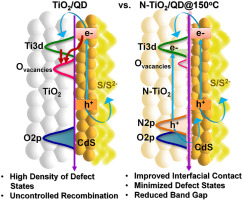当前位置:
X-MOL 学术
›
J. Alloys Compd.
›
论文详情
Our official English website, www.x-mol.net, welcomes your feedback! (Note: you will need to create a separate account there.)
Nitrogen doping of TiO2 and annealing treatment of photoanode for enhanced solar cell performance
Journal of Alloys and Compounds ( IF 6.2 ) Pub Date : 2020-08-01 , DOI: 10.1016/j.jallcom.2020.154880 P. Naresh Kumar , Aparajita Das , Melepurath Deepa
Journal of Alloys and Compounds ( IF 6.2 ) Pub Date : 2020-08-01 , DOI: 10.1016/j.jallcom.2020.154880 P. Naresh Kumar , Aparajita Das , Melepurath Deepa

|
Abstract Mild doping of nitrogen (N) in TiO2 followed by an optimized aerial annealing treatment of CdS quantum dot (QD) sensitized photoanode resulted in efficient electron transfer and low recombination rates for the corresponding quantum dot solar cell (QDSC). Nitrogen doping passivates the surface defects in TiO2, reduces the density of recombination centers, and promotes electron injection into the current collector. N-doping also modifies the electronic band structure of TiO2 and reduces the band gap from 3.17 to 2.91 eV. Therefore in the QDSC with the N-TiO2/CdS photoanode, both N-TiO2 and CdS, undergo charge separation upon illumination thereby producing a higher photocurrent compared to the undoped-TiO2/CdS based QDSC. N-doping also increased the redox activity of TiO2, allowing facile ion and electron transport across its cross-section which is advantageous for solar cell performance. Optimal annealing temperature of 150 °C for the N-TiO2/CdS or TiO2/CdS photoanode restricted the back electron movement effectively, and imparted a significantly enhanced power conversion efficiency (PCE) to the N-TiO2/CdS@150 °C/polysulfide gel/C-fabric- solar cell, greater by 55% compared to its unannealed counterpart. Lowered average excited electron lifetime, increased-incident photon-to-current conversion efficiency, recombination resistance and photovoltage decay response time, confirm the ability of the annealed photoanodes to undergo enhanced charge separation contrasting with the unannealed photoanode. This first time study relies on two simple approaches of nitrogen doping and annealing treatment to achieve considerably improved photovoltaic parameters, and opens up realistic possibilities for commercialization of QDSCs.
中文翻译:

TiO2 的氮掺杂和光阳极退火处理以提高太阳能电池性能
摘要 在 TiO2 中轻度掺杂氮 (N),然后对 CdS 量子点 (QD) 敏化光阳极进行优化的空中退火处理,可实现相应量子点太阳能电池 (QDSC) 的高效电子转移和低复合率。氮掺杂钝化了 TiO2 中的表面缺陷,降低了复合中心的密度,并促进了电子注入集流体。N 掺杂还改变了 TiO2 的电子能带结构,将带隙从 3.17 eV 降低到 2.91 eV。因此,在具有 N-TiO2/CdS 光阳极的 QDSC 中,N-TiO2 和 CdS 在照射时都会发生电荷分离,从而与基于未掺杂的 TiO2/CdS 的 QDSC 相比产生更高的光电流。N 掺杂也增加了 TiO2 的氧化还原活性,允许轻松的离子和电子跨其横截面传输,这有利于太阳能电池的性能。N-TiO2/CdS 或 TiO2/CdS 光阳极的最佳退火温度为 150 °C 有效地限制了背电子运动,并显着提高了 N-TiO2/CdS@150 °C/多硫化物的功率转换效率(PCE)凝胶/C-织物-太阳能电池,与其未退火的对应物相比增加了 55%。降低的平均激发电子寿命、增加的入射光子到电流的转换效率、复合电阻和光电压衰减响应时间,证实了退火的光电阳极与未退火的光电阳极相比具有增强的电荷分离的能力。
更新日期:2020-08-01
中文翻译:

TiO2 的氮掺杂和光阳极退火处理以提高太阳能电池性能
摘要 在 TiO2 中轻度掺杂氮 (N),然后对 CdS 量子点 (QD) 敏化光阳极进行优化的空中退火处理,可实现相应量子点太阳能电池 (QDSC) 的高效电子转移和低复合率。氮掺杂钝化了 TiO2 中的表面缺陷,降低了复合中心的密度,并促进了电子注入集流体。N 掺杂还改变了 TiO2 的电子能带结构,将带隙从 3.17 eV 降低到 2.91 eV。因此,在具有 N-TiO2/CdS 光阳极的 QDSC 中,N-TiO2 和 CdS 在照射时都会发生电荷分离,从而与基于未掺杂的 TiO2/CdS 的 QDSC 相比产生更高的光电流。N 掺杂也增加了 TiO2 的氧化还原活性,允许轻松的离子和电子跨其横截面传输,这有利于太阳能电池的性能。N-TiO2/CdS 或 TiO2/CdS 光阳极的最佳退火温度为 150 °C 有效地限制了背电子运动,并显着提高了 N-TiO2/CdS@150 °C/多硫化物的功率转换效率(PCE)凝胶/C-织物-太阳能电池,与其未退火的对应物相比增加了 55%。降低的平均激发电子寿命、增加的入射光子到电流的转换效率、复合电阻和光电压衰减响应时间,证实了退火的光电阳极与未退火的光电阳极相比具有增强的电荷分离的能力。



























 京公网安备 11010802027423号
京公网安备 11010802027423号